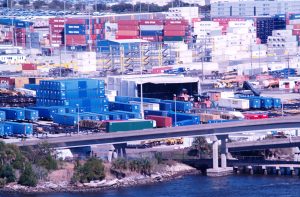
OLYMPUS DIGITAL CAMERA (JAXPORT JACKSONVILLE FLORIDA)
The word on the street is some US exporters are having a harder time finding empty containers for their goods. Is there an upcoming shortage of containers ahead? Definitely maybe is my answer. Well maybe not a true shortage as in ‘not enough’. It may be more of a matter of containers not being in the right spot. My guess is the shortage will be more prevalent for inland exporters and select inland hub areas.
The first factor I suspect will create spot shortages is money. Why do I suspect that? Because the first answer is always money of course. In this case it just may be the ocean carriers are sick of repositioning equipment in the US to serve exporters who are paying sinfully little for their outbound US to Asia containerized freight. Sure, the lines can, and do, charge repositioning fees, but to be competitive in a tight market the lines are not charging enough. Business physics dictate if they are repositioning containers anywhere near breakeven they are losing money on the effort. It would make sense the lines are darn sick of losing money on repositioning containers to load freight they are not really making money on for the ocean transit. I can’t say I blame the lines on this one. While the top global 3PL’s and mega forwarders are enjoying increased volume and higher profits, 12 of the top 25 container lines lost a collective $13 billion last checked in the third quarter of 2016. The container lines’ trying to save a buck on surface transport costs is understandable.
The second factor is more US export output in the agricultural sectors. US agriculture had a bumper year in 2016 and the outlook is good for 2017. That creates a need for more containers inland throughout the meat producing Midwest and the corn and wheat producing ‘Breadbasket’. If you consider 14 of the top 15 US export commodities are all agricultural based commodities with meat proteins included, you can see why even a slightest upward bump in production eats up (pun intended) a significant number of empty inland containers. Add in rising resin export production in the US, mostly in the Gulf States and Southeast, and there is even more competition for empty containers. Who would have thought wine would be at 23 on the list? Some things we should really keep in house.
Number three on the hit parade is something we all love, low freight rates. Due to downright cheap US to Asia container rates more commodities that were formally shipped bulk are now finding their way to containers. I outlined this trend in a February 15th 2017 article ‘To Bulk or Not to Bulk, That is The Question’ you can give a read. https://www.linkedin.com/pulse/bulk-question-tom-o-malley I happened to use agricultural and non-fuel mineral commodities as the examples.
The fourth influence for possible regional container shortages has not happened yet, but I believe it will. The upcoming ocean carrier alliances will not be designed to put more vessels into additional ports. The alliances will be structured to put fewer vessels into less port locations and make up the TEU capability by using larger Triple E mega vessels. The money saving technique of reduced ports of call will concentrate larger amounts of equipment at fewer ports. Even inland cities that are typically container rich with larger hubs such as Chicago and Atlanta may even feel the pinch. As shippers in Kansas City, St Lois, Denver and all across the Great Plains, as well as the non-food commodity producers in the South and Southeast, become hungrier for empty containers they will reach to the major inland hubs to source them.
Where do the four factors leave America’s exporters? Squarely back at factor number one, money. Money really is the only answer in some shape or form. It only differs in where the money initially comes from. Inland shippers may have to get used to the idea of paying higher repositioning fees to secure empty containers. This will be especially true for commodities that are not easily shipped overland by truck or rail to be stuffed into containers near major ports. This may be an option for some if the repositioning fees become high enough, but not all. In either case it means get your check book out. Indications are the cost of doing business very well may be going up for inland exporters.
